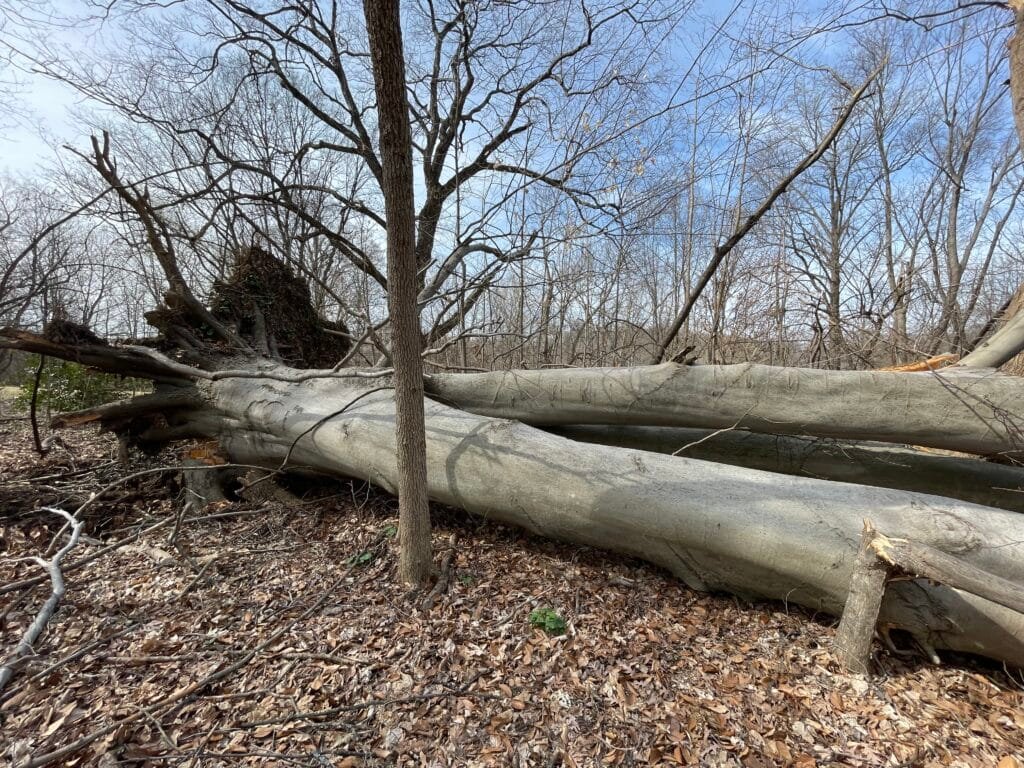Why did so many trees fall in the storm? 4 things to know and how to prevent future damage

Paul Cappiello Ph.D.
Yew Dell Botanical Gardens Executive Director
Friday, March 3, 2023 . . . If you were anywhere in Kentucky on that day you’re probably still a bit confused. It was one weird, unusual and scary meteorological event.
Never before have I experienced a community-wide school cancellation because of a rain and wind event. Never before have I experienced the bulk of weather-related damage . . . after the “storm” passed – the bulk of the destruction occurring after the rain was long over. It was a strange and dangerous day in Kentucky. Trees were lost. Cars and homes were lost. Lives were lost. With winds in excess of what hurricane Ike wrought in 2008, strange patterns or not . . . it was a beast.
As I cruised around town over the weekend, assessing the damage, some clear patterns emerged. As with any natural disaster, sometimes it is the aftermath that teaches us the most about how we can avoid it, or at least the worst of it, in the future.

Affected Species
Basically, nothing was spared. Giant old trees were downed. Newly planted trees were toppled. Middle-aged specimens were uprooted. No category of tree seemed to escape the storm’s wrath. But based on an entirely informal weekend survey, a few patterns have emerged.
Certainly there were plenty of damaged and downed specimens of our old friend the ‘Bradford’ pear (Pyrus calleryana ‘Bradford’ and related cultivars.) Their split trunks and torn out tops typical of damage resulting from characteristically weak branching structure. No surprise there.
Oaks and maples – many giant old specimens – were left blown over all around the community. But this may be a bit of a red herring. The many species of oaks and several maples, namely sugar and red maples (Acer saccharum and A. rubrum, respectively) seemed to have been hit very hard. But these two groups make up a very high percentage of big old street trees around the community. The fact that many of the trees felled by the storm fall into these two categories seems to have much more to do with their relative abundance around town rather than any innate susceptibility to wind damage. In fact, they are generally quite durable in the face of such affronts.
Location
Without question, trees in just about every situation were damaged by the March 3rd storm. But some situations seemed more problematic than others. And the biggest problem I saw around town is giant old trees growing in areas with restricted root space.
All around the community there are 3-foot, 4-foot and 5-foot diameter hulking tree trunks toppled over wires, streets and homes, with at least a part of their “root systems” being just . . . well . . . absent. Eighty-foot-tall trees growing in a narrow tree lawn – that miserly little strip between the street and the sidewalk – means that at least one side of the tree can’t put down much in the way of roots. You can see these all around town – bulging masses of trunk growth piled up and over the curb but not much in the way of roots.
So what have we learned about the best place to grow our shade and street trees? Well, really nothing. We’ve known for a long time that the secret to growing strong and stable trees is maximizing the space tree roots can explore and establish a strong foothold. Indeed, talking with Trees Louisville executive director, Cindi Sullivan and special projects manager, Mike Hayman, they confirmed that is exactly what the tree-focused non-profit does when selecting tree planting sites around town. “Often times we’re working with home and business owners to plant on private property, further back from the pavement edge, because that’s where the soil is” offered Hayman. Sullivan urges developers of new communities to consider 10-foot-wide planting strips between the curb and sidewalk to give trees a fighting chance. Also, planting on the lawn side of the sidewalk can give trees much more room to develop a healthy root system.
Of course we can’t always change the existing infrastructure so matching the size of the tree to the available rooting space is also key.
Tree Structure
This is where an ounce of prevention, especially an early ounce of prevention, is worth tons of cure. Much of the storm damage to the upper canopy of old trees showed clear signs of preventable problems. Overcrowded branches, poor branching angles, and a whole host of other structural problems predispose trees to wind and snow load breakage.
The cure for poor tree structure is early intervention. Targeted pruning of tree branches in the early part of a tree’s life can set a pattern of strong future growth. But even a good-sized tree with structural challenges can be improved with proper pruning. A knowledgeable horticulturist, nursery professional or landscape contractor can help get newly planted trees going in the right direction with some early pruning intervention. But for large, established trees, you’ll want a professional arborist.
Arborists certified by the International Society of Arboriculture are trained to understand each species and how it naturally branches. They understand how to correct branching problems to improve the structural health of trees and minimize future storm damage. Just because someone has a bucket truck
and their name on the door doesn’t mean they understand the finer points of hazard assessment and structural pruning. An ISA certified arborist is the way to go.
Finally, this is a good time to look up. Naturally, with storm events such as the one we experienced on March 3, we tend to concentrate on what’s on the ground – cleaning up the obvious problems. But sometimes the biggest problem can be what’s left up in the canopy. Broken branches stuck up in a tree’s crown, damage not visible from the ground and even remaining structural problems need to be assessed and dealt with before they do more harm. Getting a certified arborist up in your large trees to assess hazard potential is the best way to go. No tree inspection offers a 100% safety guarantee. There’s always the potential for hidden problems that can evade detection. And certainly the work isn’t cheap. But then considering the cost of another catastrophic failure, getting that work done sooner rather than later can pay big dividends.
This article was originally submitted to the Courier Journal on March 6, 2023.
About the Author

Blurb about Paul here.

